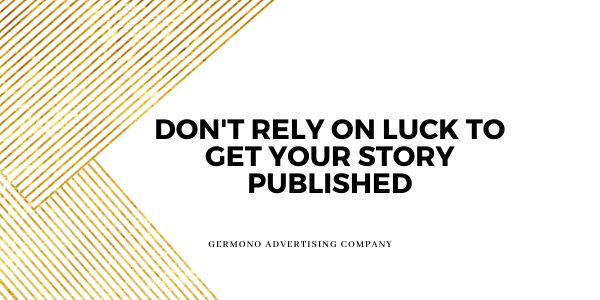
16 Mar Don’t Rely on Luck to Get Your Story Published
If you’re not a trained public relations professional, the idea of pitching a story or product to a media entity can be pretty scary. Let’s be fair, sometimes it can be scary for us pros as well. Lucky for us, we have training and relationships on our side. Lucky for you, you have us to guide you.
Pitching a story to media entities takes time, effort and strategic execution. Here are a few tips to increase your chances of getting your story published.
Tip # 1: Know your target audience and what media outlets serve them. First, it is important to know your target demographic. Who are the attendees of your event/purchasers of your product? What are their ages, sex, location, marital status, etc.? Next, research and find media entities with viewers/listeners/readers in those demographic areas. For advertising purposes, most media entities share their demographic information on their websites.
Tip # 2: Once you’ve found the right outlet, find the right contact. If you send your bridal show event information to the sports reporter, the likelihood of getting published is slim. Check the staff listings of the media entity to find the best point of contact for your story. Send your pitch to that person.
Tip # 3: Once you know who to pitch, know how to pitch. Email is king. I’ve attended several events lately and have heard this from radio, print and television journalists and producers. Most media entities prefer to receive pitches via email. Some have even gone to news submission forms on their websites. While a call won’t hurt, if you are lucky enough to catch one of these busy professionals on the phone, they will more than likely ask you to follow up with an email. It is important to know what to provide in the email so here are some tips:
- Have a catchy subject line. Not catchy in an over the top, all caps, extra exclamation points way, catchy in a well-written way that stands out from the 156,156,745 other emails they will receive that day.
- Don’t send an email and just attach a press release. Put the important information in the body of the email.
- Lead with the important information. Be direct. Get to the point. Eliminate clutter and unnecessary verbiage such as superlatives and fancy words. They’ll decide if your event will be “awesome” or not.
- Include media such as relevant photos and video. The more you can provide to help tell your story, the better. Newsrooms are shrinking and helping a reporter out does not hurt. I would suggest uploading these items to a file sharing site and sharing the link because many email firewalls will block attachments. I recommend Dropbox. This is also a great tip for event coverage. Many times, journalists can’t get to every event. Snap some photos and video and send an event recap pitch. Photos and video do not need to be professional. Cell phone photos and videos have been used in news coverages.
Tip #4: Don’t be afraid to follow up. I’m in no way suggesting that you badger a journalist, but it is okay to send a follow-up email. Like I said, we’re all busy and many times stories can be overlooked.
We hope today brings a lot of luck your way, but hopefully with these tips you won’t need it. I’m always happy to answer your public relations questions. Reach out to me at lindsey@germono.com.
